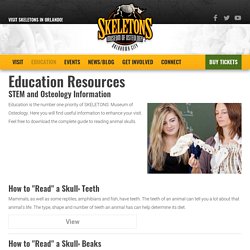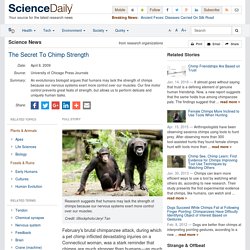

The Story of the Animal Kingdom.
Comparative Reproduction. Education Resources. STEM and Osteology Information Education is the number one priority of SKELETONS: Museum of Osteology.

Here you will find useful information to enhance your visit. Feel free to download the complete guide to reading animal skulls. How to "Read" a Skull: Teeth Mammals, as well as some reptiles, amphibians and fish, have teeth. How to "Read" a Skull: Beaks The beak of a bird is an extension of its skull and is designed for feeding. How to "Read" a Skull: Eye Placement and Size What do the eye sockets of a skull tell you about an animal?
How to "Read" a Skull: Horns and Antlers Horns or antlers found on a skull bear evidence of how an animal communicated, defended its self and possibly the animals sex. How to "Read" a Skull: Pathology The pathology of a skull can tell you what may have caused an animals death. How to Identify a Skull When using skulls in education, the first question usually asked is "What kind of skull is that"?
The Story of the Animal Kingdom. The Story of the Animal Kingdom. Lesson Plans. Science Underground. Dogs bark.

Cats meow. Ducks quack. These noises might not seem like much to us, but animals are communicating. We’ve been intrigued with communicating with animals since the classic movie Dr. Dolittle from the 1960s and the revamped version of this movie in the 1990s with Eddie Murphy. But the fascinating part about animal language is time. All this is to say it that the chirps or barks you hear are full of compressed information.
Find out more about animal language here: Chasing Dr. The Secret To Chimp Strength. February's brutal chimpanzee attack, during which a pet chimp inflicted devastating injuries on a Connecticut woman, was a stark reminder that chimps are much stronger than humans—as much as four-times stronger, some researchers believe.

But what is it that makes our closest primate cousins so much stronger than we are? One possible explanation is that great apes simply have more powerful muscles. Indeed, biologists have uncovered differences in muscle architecture between chimpanzees and humans. But evolutionary biologist Alan Walker, a professor at Penn State University, thinks muscles may only be part of the story.
In an article published in the April issue of Current Anthropology, Walker argues that humans may lack the strength of chimps because our nervous systems exert more control over our muscles. Walker's hypothesis stems partly from a finding by primatologist Ann MacLarnon. More grey matter in humans means more motor neurons, Walker proposes. Virtual Labs. The links on this page are all VIRTUAL LABS offered by the Glencoe textbook company.

These labs give the students the adventure of laboratory experimentation without costly supplies, worrisome environmental and safety issues, or time-consuming clean up. They are from all different areas of science: Biology, Physics, Genetics, Earth Science, Physical Science, and Chemistry. Please feel free to try these at home! Students will be directed to specific labs in class but there are over 100 labs offered here! To return to the home page, please click here: Virtual Labs 1) What strategies are involved in solving a science problem? 2) How does thermal energy affect the state of a substance?
3) How can minerals be defined by their properties? 4) How are rocks classified? LifeSciTRC.org - Life Science Teaching Resource Community. Brain Games. McGraw-Hill Virtual Biology Lab. Zoology. What can I learn from worms? Regeneration, stem cells, and models. U1_L5_LessonPlan.pdf. Curriculum from the Monterey Bay Aquarium. The Story of the Animal Kingdom. Taxonomy browser (root) ADW: Home. ARKive - Discover the world's most endangered species. Wildscreen's Arkive project was launched in 2003 and grew to become the world's biggest encyclopaedia of life on Earth. With the help of over 7,000 of the world’s best wildlife filmmakers and photographers, conservationists and scientists, Arkive.org featured multi-media fact-files for more than 16,000 endangered species.
Freely accessible to everyone, over half a million people every month, from over 200 countries, used Arkive to learn and discover the wonders of the natural world. Since 2013 Wildscreen was unable to raise sufficient funds from trusts, foundations, corporates and individual donors to support the year-round costs of keeping Arkive online. Therefore, the charity had been using its reserves to keep the project online and was unable to fund any dedicated staff to maintain Arkive, let alone future-proof it, for over half a decade.
Despite appeals for support, just 85 of our 5.6 million users in 2018 made a donation. P358-359 - jcst9703_358. Ss0707_24.